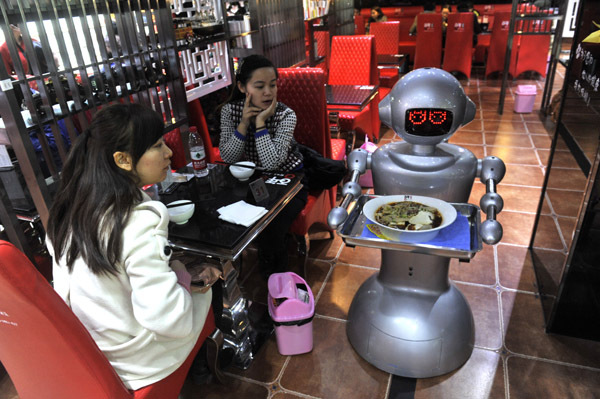Look out, there’s a robot just waiting to take over your job
By Korea HeraldPublished : Jan. 6, 2015 - 20:49
They are cheaper, don’t get tired, won’t strike, and they might be better than you. In a restaurant newly opened in Chengdu, capital of Sichuan province, four robots are busy waiting tables.
The robots, 1.3 meters tall and capable of lifting up to 3 kilograms, can deliver dishes, collect empty plates and communicate with customers in simple sentences. Restaurant owner Zong Ning said that one such robot could serve 10 tables, replacing at least two waiters.
“The robots are 100 percent obedient and require charging only once a day. They are more efficient than waiters and waitresses,” said Zong.
Each of the robots costs 70,000 yuan ($11,300). Zong said that it would take just one year to recover the money he has spent buying the robots compared with the money he is saving on human labor costs.
The robots, 1.3 meters tall and capable of lifting up to 3 kilograms, can deliver dishes, collect empty plates and communicate with customers in simple sentences. Restaurant owner Zong Ning said that one such robot could serve 10 tables, replacing at least two waiters.
“The robots are 100 percent obedient and require charging only once a day. They are more efficient than waiters and waitresses,” said Zong.
Each of the robots costs 70,000 yuan ($11,300). Zong said that it would take just one year to recover the money he has spent buying the robots compared with the money he is saving on human labor costs.

While consumers are still impressed by robot waiters employed by restaurants, it is easy to imagine that they will appear more and more in our daily lives. Some might even take over our jobs.
In October, Oxford University published a study of the application of robotics in the U.S. labor force. It found that it is possible that as much as 47 percent of the labor force could be replaced with robots over the next two decades.
In China, the robotic revolution is moving forward in giant steps. In order to offset rising labor costs and a shortage of skilled workers, major problems plaguing China, robots are applied for many different uses.
Statistics show that industrial robots are being used in 25 sectors in China, including food, chemicals, electronics and automobiles.
According to the China Robot Industry Alliance, China has already overtaken Japan as the world’s largest consumer of robots, buying more than one-fifth of the world’s robot output.
Last year, 36,860 industrial robots were sold in the Chinese market, a growth of 36 percent year-on-year.
Song Xiaogang, president of the CRIA, said that the number of robots sold in China would reach 50,000 this year.
“From now on, the robot industry will maintain an annual growth rate of 40 percent for a long period of time,” he said.
The rapid growth has encouraged Chinese companies to share a slice of the market.
By the end of October, China had more than 430 companies manufacturing robots. An average of two new companies joins the sector every week.
Song said that apart from robotic workers in manufacturing industries, which account for most robot application in China, he sees a growing demand for self-driving cars, delivery drones and even robot journalists by 2030.
“Many people find the artificial intelligence in movies like Interstellar amazing. It is not impossible that they will exist in the future. By then, robots will take over many human jobs,” said Song.
By Yan Yiqi
(China Daily)
-
Articles by Korea Herald









![[Kim Seong-kon] Democracy and the future of South Korea](http://res.heraldm.com/phpwas/restmb_idxmake.php?idx=644&simg=/content/image/2024/04/16/20240416050802_0.jpg&u=)








![[KH Explains] Hyundai's full hybrid edge to pay off amid slow transition to pure EVs](http://res.heraldm.com/phpwas/restmb_idxmake.php?idx=652&simg=/content/image/2024/04/18/20240418050645_0.jpg&u=20240418181020)

![[Today’s K-pop] Zico drops snippet of collaboration with Jennie](http://res.heraldm.com/phpwas/restmb_idxmake.php?idx=642&simg=/content/image/2024/04/18/20240418050702_0.jpg&u=)